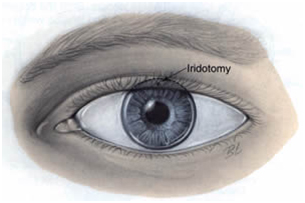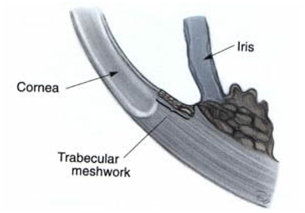Overview
Laser Iridotomy Uses A Very Focused Beam Of Light To Create A Hole On The Outer Edge, Or Rim, Of The Iris, The Colored Part Of The Eye. This Opening Allows Fluid To Flow Between The Anterior Chamber, The Front Part Of The Eye, And The Area Behind The Iris, The Posterior Chamber. This Opening May Decrease Pressure In The Eye And Usually Prevents Sudden Buildup Of Pressure Within The Eye, Which Occurs During An Episode Of Acute Closed-Angle Glaucoma.
Some People Feel A Sensation Of Heat In The Eye During Laser Surgeries. But There Usually Is No Pain After Laser Iridotomy.
What Is A Laser Iridotomy?
Closed-Angle (Of Pupillary-Block) Glaucoma Is One Of Many Types Of Glaucoma. Often It Can Be Cured Through A Procedure Called An Iridotomy. To Better Understand Closed-Angle Glaucoma And Its Treatment, Iridotomy (Figure 1), It Is Important To Understand The Different Factors Which Determine Eye Pressure.

Figure 1: - In Laser Iridotomy, A Small Hole Is Placed In The Iris (The Colored Portion Of The Eye). In Most Patients, The Iridotomy Is Placed In The Upper Portion Of The Iris And Cannot Be Seen Under The Upper Eyelid.
What Is Eye Pressure?
Aqueous Humor (The Nourishing Fluid Within The Front Of The Eye) Leaves The Eye Through A Tiny Drain Called The Trabecular Meshwork (Figure 2).

Figure 2: Aqueous Humor Leaves The Eye Through A Tiny Drain Called The Trabecular Meshwork, Which Is Located Just In Front Of The Iris.
The Trabecular Meshwork Is Located On The Side Of The Eye, Just In Front Of The Iris (The Part Which Gives An Eye Color). Since The Fluid Is Made Just Behind The Iris, It Must Pass Between The Iris And Lens Before Leaving Through The Trabecular Meshwork (Figure 3a).

Figure 3a Figure 3b
Figure 3a. (Normal Fluid Outflow) In The Normal Eye, Fluid Passes Between The Iris And Lens Before Leaving Through The Trabecular Meshwork In The Front Of The Eye.
Figure 3b. (Pupillary-Block Glaucoma) In Pupillary-Block Glaucoma, A Type Of Closed-Angle Glaucoma, The Flow Of Fluid Between The Iris And Lens Is Blocked And The Pressure Builds In The Eye. As It Rises, The Iris Is Pushed Forward.
The Balance Between How Much Fluid Is Made, And How Much Leaves The Eye, Determines The Pressure Within The Eye. All Eyes Have Measurable Pressure. However, When The Amount Of Aqueous Humor Draining From The Eye Is Reduced, The Pressure Within The Eye Can Increase. This High Pressure Often Leads To Glaucoma.
Although Many People Think Of Glaucoma As Just One Single Disease, In Fact There Are Many Different Forms Of Glaucoma. Differences Depend Upon Where In The Eye The Blockage To The Drainage Occurs. Both The Border Between The Iris And Lens As Well As The Trabecular Meshwork Are Areas Where The Flow Of Aqueous Can Be Limited, Leading To Increased Eye Pressure. One Type Of Glaucoma, Pupillary-Block Glaucoma, Occurs With The Former. In This Type Of Closed-Angle Glaucoma, The Flow Of Fluid Between The Iris And Lens Is Blocked (Figure 3b). It Is Called Pupillary-Block Glaucoma Because The Fluid Is Trapped Behind The Pupil.
What To Expect After Surgery ?
Laser Iridotomy Can Be Done Without Admitting The Person To A Hospital. The Person May Need To See His Or Her Doctor 1 Hour After Laser Surgery. The Person Will Also Need To See The Doctor For A Follow-Up Examination As Recommended.
Why It Is Done ?
Laser Iridotomy Is Used To : -
- Treat Closed-Angle Glaucoma After The Pressure In The Affected Eye Has Been Reduced With Medicine Or When Medicines Fail.
- Prevent Closed-Angle Glaucoma In People Who Have Narrow Drainage Angles And Those People Who Have Had Closed-Angle Glaucoma In Their Other Eye.
How Well It Works
- Laser Iridotomy Can Prevent Further Episodes Of Sudden (Acute) Closed-Angle Glaucoma.
- Laser Iridotomy Can Usually Prevent Slow-Forming (Subacute) Closed-Angle Glaucoma In People Who Are At Risk For Closed-Angle Glaucoma.
- Sometimes People Can Take Less Medicine To Treat Glaucoma After Having Laser Iridotomy.
Risks
Complications Of Laser Iridotomy May Include : -- Brief Blurred Vision (Common).
- Swelling Of The Clear Covering (Cornea) Of The Iris.
- Bleeding.
- Increased Pressure In The Eye.
- Closure Of The New Opening. A Second Surgery Might Be Needed If The New Opening Closes.
- Burn To The Inner Lining Of The Eye (Retinal Burn). This Is A Very Rare Complication.
Later Complications That May Develop Include : -
- Worsening Of Clouding Of The Lens (Cataract) That Was Present Before Laser Treatment.
- Closure Of The Opening.
- Recurrent Closed-Angle Glaucoma.
- Development Of Another Type Of Glaucoma.
- Continuing Need For Medicines (Depends On The Person's Condition Before Laser Treatment).
- Glare From Light Entering Through The New Opening.
For more information, medical assessment and medical quote
as email attachment to
Email : - info@wecareindia.com
Contact Center Tel. (+91) 9029304141 (10 am. To 8 pm. IST)
(Only for international patients seeking treatment in India)










